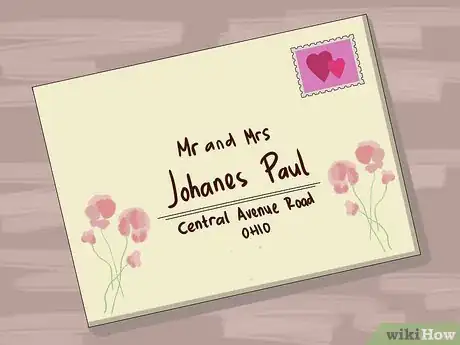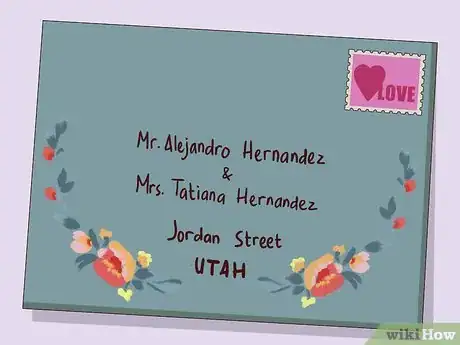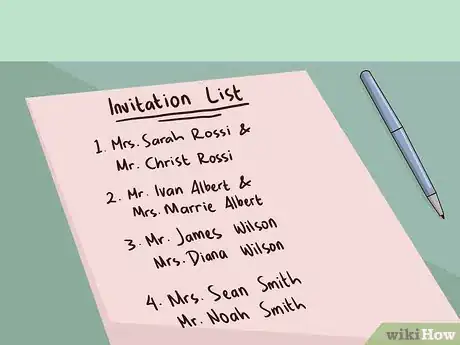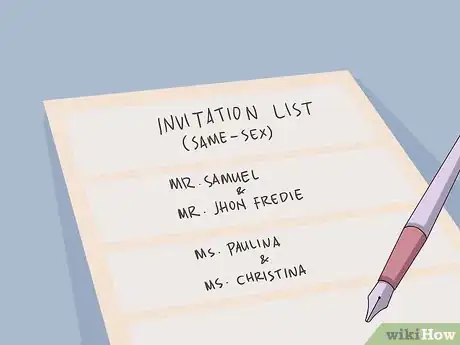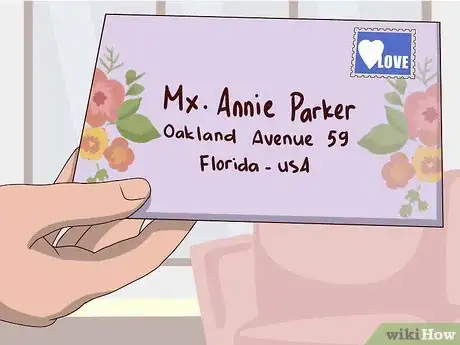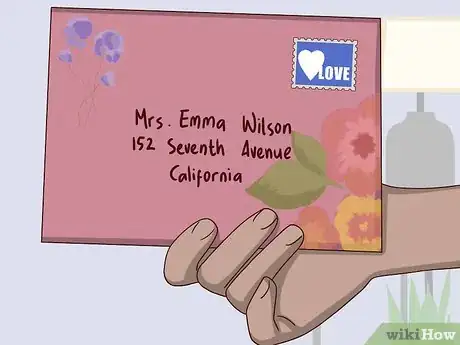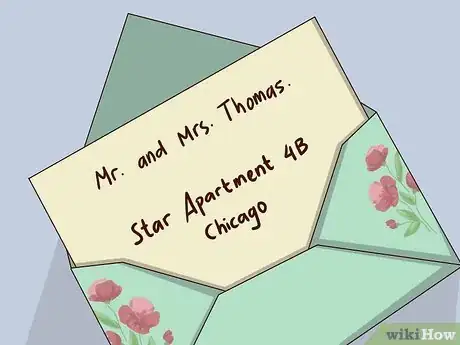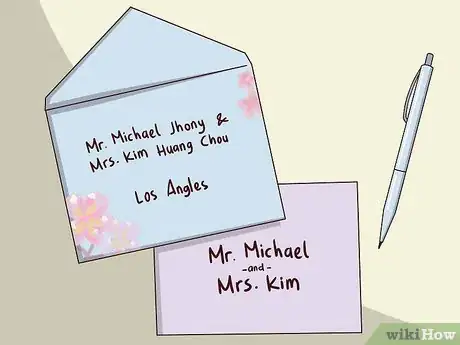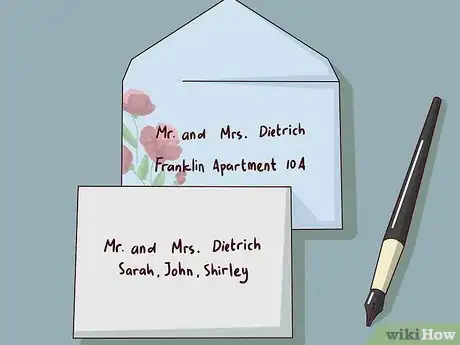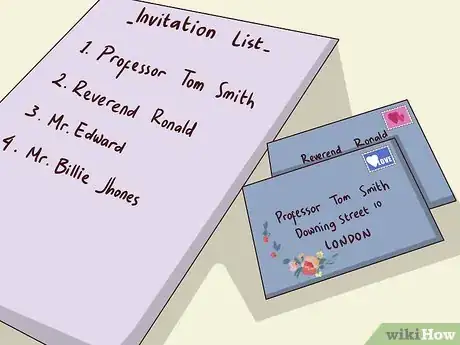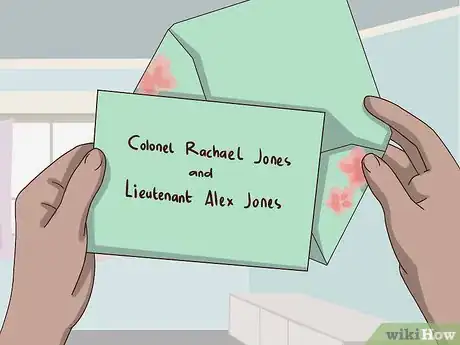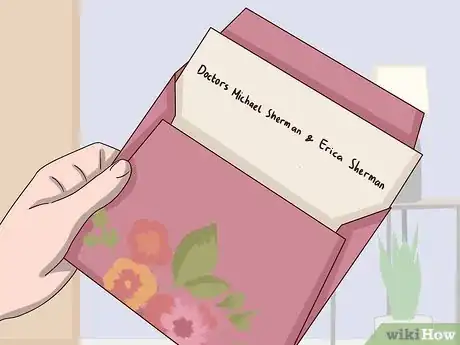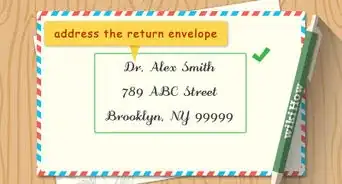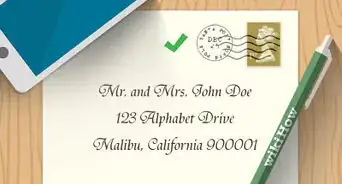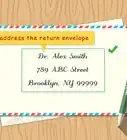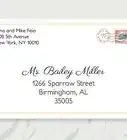This article was co-authored by Ivy Summer. Ivy Summer is a Certified Wedding Planner and the Owner of Voulez Events. Ivy has over 10 years of experience consulting, planning and coordinating weddings around the globe. She has also created a DIY online wedding planning workshop for couples, called "Plan Your Wedding Like A Pro." She currently resides in Greece where she continues to work with a worldwide network of planners and wedding professionals.
There are 11 references cited in this article, which can be found at the bottom of the page.
This article has been viewed 10,682 times.
Tons of planning goes along with throwing a wedding, so naturally you want to avoid as much stress as possible. Through the whole planning process, you might be unsure of how to address the invitations to your married friends and family. The process is a bit complicated, but don’t worry – with some pre-planning, you’ll address all your invitations correctly and all your guests will be happy.
Steps
Creating the Front Envelope
-
1Use “Mr. and Mrs.” + the husband’s full name for a traditional approach. This was the proper way to address invitations to married couples for a long time, so use it if you’re going for a more traditional or old-fashioned style. Write “Mr. and Mrs.” followed by the husband’s full name. Include the middle name if you know it, or leave it out if you don’t.[1]
- For example, if the married couple was Thomas and Jane Smith, the invitation would read, “Mr. and Mrs. Thomas Smith.” If you know that Thomas’ middle name is Joseph, then the full address would be “Mr. and Mrs. Thomas Joseph Smith.”
- Remember that this is a bit old-fashioned, and some women may oppose having their name grouped in with their husband’s. Adjust your approach based on whether you prefer to be modern or traditional.
- You can also write the man's first name, the word "and," the woman's first name, and their last name.[2]
-
2Write each partner’s full name and title for a more modern style. The modern approach is listing each partner separately, even if they have the same last name. Precede each partner with “Mr.” or “Mrs.”, then list their full name. For example, “Mr. Alejandro Hernandez and Mrs. Tatiana Hernandez.”[3]
- To save room, it’s also acceptable to list them as “Mr. Alejandro and Mrs. Tatiana Hernandez.”
- This also covers the possibility that the husband and wife have different last names, which is growing more common. Simply list each partner separately with their full title.
- Some brides hyphenate their last name to keep their maiden name but include their husband’s name as well. In this case, follow the same procedure and list each partner by their full name, like with “Mr. Brian Jackson and Mrs. Tiffany Brown-Jackson.”
Advertisement -
3List the person that you’re closest to first if you don't know the couple equally. While it’s traditional to list the husband first on official invitations, it’s now appropriate to order the couple based on who you’re closer to. If you’re inviting your friend Sarah and her husband Chris, then the invitation can read, “Mrs. Sarah Rossi and Mr. Chris Rossi.” Use this style if you’re not grouping the husband and wife’s names.[4]
-
4Print each partner’s full name and title for a same-sex couple. Address invitations to same-sex couples the same way you’d address them to opposite-sex couples listed separately. Begin each partner with their proper title, followed by their full name.[5]
- If the couple was Adam and Bruce Acheson, then address the envelope as “Mr. Adam and Mr. Bruce Acheson.” Use the same format for women, but with the title “Mrs.”
- Also list a same-sex couple starting with the partner that you’re closest with. If you’re equally close to them, then just go in alphabetical order.
-
5Use the preferred pronouns for trans or non-binary people. List trans or non-binary couples the same way that you’d list other couples, just with their preferred pronouns. Follow the pronoun with their full name.[6]
- Some trans people also change their first name to match their gender identity. In this case, make sure you use their adopted name rather than their birth name.
- Some non-binary people prefer “Mx.” for their title as a gender-neutral term.[7]
- If you aren’t sure about correct pronouns, you can always contact the couple and ask what they prefer. They’ll appreciate your inquiry and effort to include them.
-
6Write out the complete address without using any abbreviations. With both names and addresses, don’t use abbreviations on wedding invites. Spell out the whole address, without special signs or abbreviations.[8]
- For example, if an address is “152 7th Ave.,” write it out as “152 Seventh Avenue.” You can still use numerals for the house or apartment number is it's greater than 20. If it's less than 20, write it out as well.[9]
- Also write out state names in full, rather than using abbreviations. Write “California” instead of “CA,” for example.
- Limit your invitations to 1 per household. If you're offering a plated meal at your wedding, include as many meal cards as household members.[10]
Writing the Inner Envelope
-
1Send an inner envelope if you want to be more traditional. Inner envelopes are optional. The point is providing the invited couple with a fresh, clean envelope for display if the outer envelope gets damaged. If you want to provide a more traditional feeling, then send an inner envelope.[11]
- The inner envelope is less formal than the front one and doesn't need any mailing information. Just include the couple's named, properly filled out.
- If you don't feel strongly about including an inner envelope, then you'll probably save money by leaving it out.
-
2Use first names on the inner envelope if you’re close to the couple. The inner envelope on wedding invitations is less formal than the front. If you know the couple well, then just use first names there, like “Michael and Kim,” rather than their proper titles. Also list them in the order that you listed them on the front envelope.[12]
- If you have a family relationship with the couple, you can use it on the inner envelope. For example, “Uncle Pat and Aunt Rosa.”
- If you’re not as close with the couple, then simple use “Mr. and Mrs.” for the inner envelope.
-
3Include children on the inner envelope if they’re invited. Traditionally, the front envelope is only addressed to the parents. If you’re also inviting their children, then list them on the second line after their parents.[13]
- If you’re being proper, then list the couple with their titles and last names, followed by the children. For example, “Mr. and Mrs. Dietrich, Sarah, John, and Shirley.” Otherwise, just use everyone’s first names.
Including Distinguished Titles
-
1List the person with the distinguished title first. Whether a person is a doctor, military member, judge, or another title, the partner with a title socially “outranks” the other. List them first, regardless of gender.[14]
- If both partners have a distinguished title, then list the person that you’re closest to first.
- The most common distinguished titles are Doctor or military ranks. Other titles are “The Honorable” for judges, “Reverend,” or “Professor.”
-
2Spell out titles without abbreviations. Just like with addresses, the professional title shouldn’t contain abbreviations. Spell out the titles entirely on the front envelope. If you have an inner envelope, you can abbreviate the titles there.[15]
- If the titles and names are too long for one line, make a new line for the second partner and indent it.
-
3Order military service members according to their rank. If both partners are in the military but have different ranks, list them according to their rank, regardless of gender. For example, if one partner is a Lieutenant and one is a Colonel, the Colonel is listed first. Make the invitation out to “Colonel Rachael Jones and Lieutenant Alex Jones.”[16]
- It’s easy to find out which rank is higher. Just do an internet search for military ranks to find out.
- If the partners share the same rank, then list them based on who you’re closest with.
-
4Make the title plural if both partners have the same one. It’s common for some couples to share a title, like if both are doctors. In this case, you can make the title “Doctors” and list each partner’s full name after.[17]
- In a couple with 2 doctors, for example, write the card as, “Doctors Michael Sherman and Erica Sherman.”
- This works for couples with the same military ranks as well. For example, "Sergeants Eric and Kaitlin Strasser."
References
- ↑ https://www.southernliving.com/weddings/how-to-address-wedding-invitations?slide=03fb0ab6-a23e-4500-8751-4e95993dfc11#03fb0ab6-a23e-4500-8751-4e95993dfc11
- ↑ Ivy Summer. Certified Wedding & Event Planner. Expert Interview. 17 August 2021.
- ↑ https://www.brides.com/story/how-to-address-your-wedding-invitations
- ↑ https://www.southernliving.com/weddings/how-to-address-wedding-invitations?slide=cb51544c-3743-4848-be9b-e87356031a0a#cb51544c-3743-4848-be9b-e87356031a0a
- ↑ https://www.brides.com/story/how-to-address-your-wedding-invitations
- ↑ https://apracticalwedding.com/trans-non-binary-inclusive-wedding/
- ↑ https://www.usatoday.com/story/opinion/2019/02/28/mx-honorific-courtesy-title-nonbinary-non-comforming-transgender-folks-identity-column/2993966002/
- ↑ https://www.southernliving.com/weddings/how-to-address-wedding-invitations?slide=03fb0ab6-a23e-4500-8751-4e95993dfc11#03fb0ab6-a23e-4500-8751-4e95993dfc11
- ↑ https://www.marthastewartweddings.com/228650/addressing-and-mailing-your-wedding-invitations?slide=e371cbff-da9b-48b4-b2e7-d15e8fa5d419#e371cbff-da9b-48b4-b2e7-d15e8fa5d419
- ↑ Ivy Summer. Certified Wedding & Event Planner. Expert Interview. 17 August 2021.
- ↑ https://www.marthastewartweddings.com/228650/addressing-and-mailing-your-wedding-invitations?slide=f9d79b72-86d6-4bfb-b1d9-b09fd1dec0e2#f9d79b72-86d6-4bfb-b1d9-b09fd1dec0e2
- ↑ https://www.brides.com/story/how-to-address-your-wedding-invitations
- ↑ https://www.marthastewartweddings.com/377903/how-to-address-wedding-invitation-envelopes?slide=5f22e61b-528b-45fe-8b55-6d2c9f7302e4#5f22e61b-528b-45fe-8b55-6d2c9f7302e4
- ↑ https://www.marthastewartweddings.com/377903/how-to-address-wedding-invitation-envelopes?slide=4180c850-4f0e-430b-b27b-dd9bab56727d#4180c850-4f0e-430b-b27b-dd9bab56727d
- ↑ https://www.brides.com/story/how-to-address-your-wedding-invitations
- ↑ https://www.brides.com/story/how-to-address-your-wedding-invitations
- ↑ https://www.brides.com/story/how-to-address-your-wedding-invitations
- ↑ https://www.brides.com/story/wedding-guest-list-plus-one-etiquette-who-gets-one
